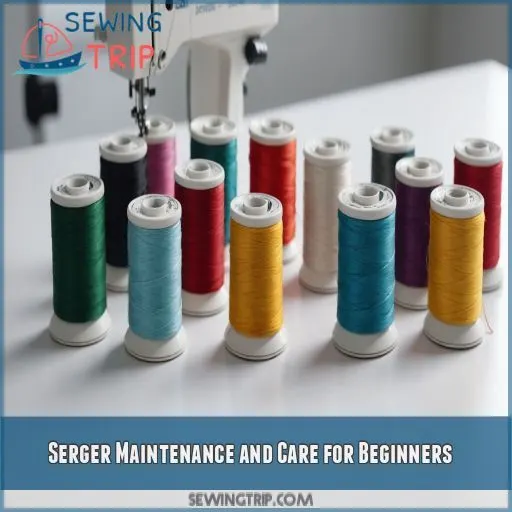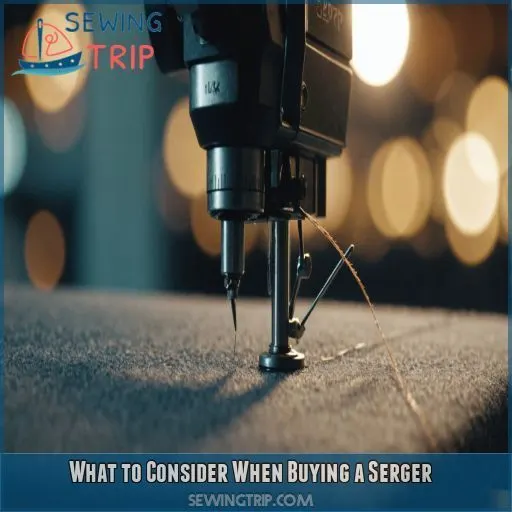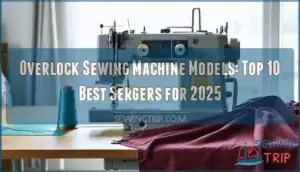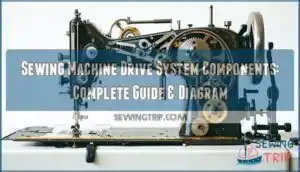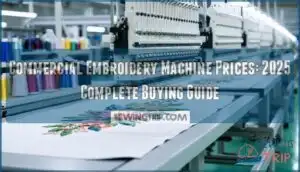This site is supported by our readers. We may earn a commission, at no cost to you, if you purchase through links.
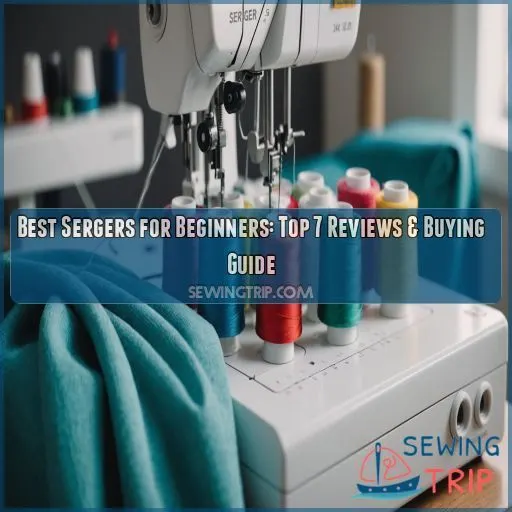 Looking for the best sergers for beginners reviewed? You’re in luck!
Looking for the best sergers for beginners reviewed? You’re in luck!
As a beginner, you want a serger that’s easy to use, reliable, and won’t break the bank.
Top picks include the Singer ProFinish 2, 3, 4 Thread Serger, Brother Serger 1034DX Overlock Machine, and Juki MO 1000 Serger Push Button.
These machines offer features like color-coded threading, built-in trimmers, and adjustable differential feeds.
But before you buy, consider factors like threading ease, stitch options, and budget.
Want to become a serger pro? Start by mastering the basics, and you’ll be sewing like a dream in no time!
Table Of Contents
Key Takeaways
- The Brother 1034D is a top choice for beginners due to its user-friendly interface, color-coded threading, and versatile stitch options.
- Sergers are a worthwhile investment for beginners who plan to sew frequently, work with stretchy fabrics, or desire professional-looking seams.
- Brother, Babylock, Juki, and Singer are popular serger brands, offering a range of features and price points to suit different needs and budgets.
- Regular cleaning, lubrication, and the use of high-quality needles and threads are essential for maintaining your serger and ensuring smooth stitching.
Top 7 Sergers for Beginners
Ready to get started with sergers? We’ve rounded up the top seven beginner-friendly options to get you stitching like a pro.
1. Singer ProFinish 2 3 4 Thread Serger
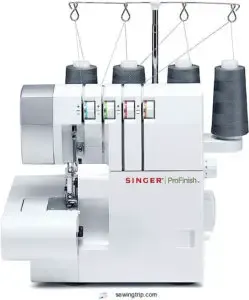
If you’re looking for a reliable serger that’s easy to use, the Singer ProFinish 2, 3, 4 Thread Serger is a great option.
This serger sews up to 1,300 stitches per minute and can handle a variety of fabrics, from lightweight knits to bulky terry cloth.
Here’s what makes it a standout:
- Color-coded threading: Makes setup a breeze.
- Built-in trimmer: Saves time by cutting seams as you work.
- Durable construction: Made with more metal than plastic, this machine is built to last.
- Easy maintenance: Parts are easy to find and affordable.
Best For: The Singer ProFinish 14CG754 Serger is ideal for beginners and sewers who want a reliable machine for handling a variety of fabrics.
- Easy to use: Color-coded threading and a built-in trimmer make it user-friendly.
- Durable: Made with more metal than plastic, it’s built to last.
- Versatile: Handles a range of fabrics, from delicate knits to thicker terry cloth.
- Learning curve: It might take some practice to master serging.
- Tension Adjustment: You’ll need to learn how to adjust tension for different fabrics.
- Price: While the price may have dropped, it can still be expensive for some.
2. Brother Serger 1034DX Overlock Machine
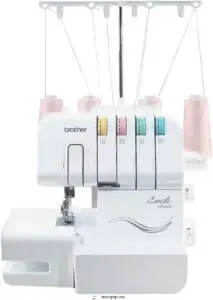
The Brother Serger 1034DX is a speedy demon that’ll have you zipping through projects. With a sturdy metal frame, this serger can handle whatever you throw at it—even multiple layers of denim. Color-coded guides make threading a breeze, and the ability to switch between three or four threads gives you versatility. It’s a great value buy, with users praising its ease of use and durability. Just remember to keep it well-lubricated and use good-quality thread to keep things running smoothly.
Best For: Sewing enthusiasts who want a durable and versatile serger that’s easy to use.
- Handles thick fabrics with ease
- Offers both 3- and 4-thread options for versatility
- Comes with essential accessories and a protective cover
- Requires regular lubrication
- Thread quality can impact performance
- Threading can be tricky for beginners
3. Juki MO 1000 Serger Push Button
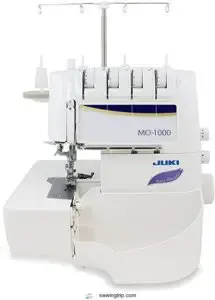
Next up, we’ve got the Juki MO 1000 Serger Push Button. This baby’s got air threading, so you can kiss the hassle of threading multiple loops goodbye. It also features an automatic needle threader, saving you from eye strain and frustration. With the upper looper converter, you can effortlessly switch between 2-thread and 3-thread sewing. The adjustable differential feed will be your best friend when working with stretchy fabrics. Plus, the wide fabric throat area gives you room to maneuver. It’s a quiet operator, too, so you won’t disturb the whole neighborhood.
Best For: The Juki MO-1000 is best for sewers who want an easy-to-use serger with great features.
- Air threading makes threading a breeze.
- The adjustable differential feed is great for stretchy fabrics.
- The wide throat area provides ample space for working.
- Needle threading can be tricky for some users.
- The included tutorials may not cover all aspects of the machine.
- Some users have reported issues with the air threader and customer support.
4. Janome 8002D Serger With Bonus Accessories
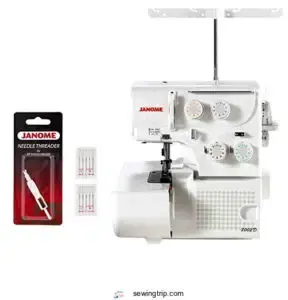
The Janome 8002D Serger is a solid choice for beginners. It comes pre-threaded, which makes setup easy. This machine is quiet, lightweight, and stable thanks to its suction cups. It’s durable, too, and comes with a good warranty. You’ll get a DVD and clear instructions, making it user-friendly. It’s versatile and great value for money. But, some users report thread breaking issues, and you’ll need to buy a dust cover separately. This serger is a great option if you’re willing to practice and put in some effort to master it.
Best For: Beginners looking for a user-friendly serger with a good price-to-value ratio.
- Comes pre-threaded, making setup easy.
- Quiet operation and lightweight design.
- Durable and comes with a good warranty.
- Some users report thread breaking issues.
- No dust cover included.
- Requires practice to master threading and other techniques.
5. JUKI MO654DE Portable Serger
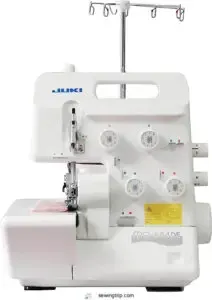
Next up, we’ve the JUKI MO654DE Portable Serger. This machine is a reliable workhorse, offering both power and versatility. It sews through light to heavy fabrics with ease, thanks to its durable knives and powerful knife system. The differential feed gives you control when sewing knits, and the rolled hem function adds a pro finish. Users report the threading process is a breeze, and its performance is smooth and consistent. This serger is a great choice if you’re after a balance of features and value. It’s a popular pick for beginners and experienced sewers alike.
Best For: The JUKI MO654DE Portable Serger is best for beginners and experienced sewers looking for a versatile and reliable serger with a good balance of features and value.
- Durable knives handle a wide range of fabrics, even thick materials like denim.
- Differential feed provides control when sewing stretchy knits.
- Rolled hem function adds a professional finish to edges.
- Lighting: Uses a standard light bulb, not LED, which might be a factor for some users.
- Coverstitch: Does not have a coverstitch function.
- Manual: May need to be supplemented with a dedicated serger guidebook for more comprehensive information.
6. Bernette 64 Airlock Serger
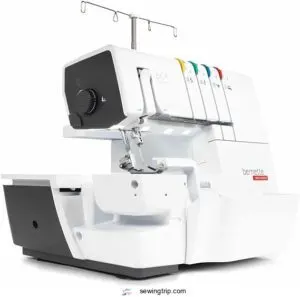
The Bernette 64 Airlock Serger is packed with features, but there are a few things to consider.
Here’s what you get:
- Automatic air-threading for the loopers
- Free arm for circular sewing
- Free Hand System with a knee lifter
- Thread tension release when you lift the presser foot
- Micro Thread Control
- 16 stitches
- Sewing speed of 1300 spm
- Bright LEDs
But, keep in mind:
- Potential issues with the warranty
- Air threading may not always be reliable
- Can be noisy
- Packaging might not be the best
This serger is a solid choice, but it’s worth doing your research and reading reviews before you buy.
Best For: Sewers who want a serger with lots of features and a good price point.
- Automatic air threading for the loopers
- 16 different stitches
- Free Hand System with a knee lifter
- Potential warranty issues
- Air threading can be unreliable
- Can be noisy
7. Brother Coverstitch Serger 2340CV
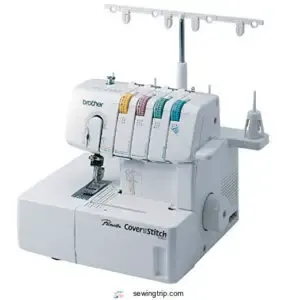
The Brother Coverstitch Serger 2340CV is a speedy and versatile machine. With a metal frame, it’s built to last. It’s a 2-needle, 2-3-4 cover stitch machine, perfect for stretch fabrics and hems. You can also create wide and narrow cover stitches for different looks. Color-coded threading makes it easier to get started, and it clocks in at 1,100 stitches per minute. The stitch length and speed are adjustable, and it comes with a 25-year limited warranty. However, it’s designed for 120 volts, so keep that in mind if you live outside the US.
Best For: The Brother Coverstitch Serger 2340CV is best for sewers who want a reliable, fast machine for working with stretch fabrics and adding professional-looking finishes to their projects.
- Metal frame: It’s built to last.
- Versatile: It handles a variety of cover stitch options.
- Easy threading: Color-coded guides make it user-friendly.
- Voltage: Only compatible with 120 volts.
- Learning curve: Threading and tension can be tricky for beginners.
- Skipping stitches: Some users report occasional skipping stitches.
Serger Maintenance and Care for Beginners
Taking care of your serger is a must to keep it in tip-top shape and make sure it lasts for years. Regular maintenance and proper care will save you from costly repairs and keep your projects running smoothly.
Regular Cleaning and Lubrication
Your serger needs TLC, too.
Keep it in tip-top shape with regular cleaning and lubrication.
Use a soft brush to sweep away lint and dust bunnies.
Then, oil it up with sewing machine oil, focusing on the moving parts.
This simple routine keeps your serger humming along smoothly and prevents those pesky thread breaks.
Aim for a quick clean after each project and a deeper dive every few months.
Using High-Quality Needles and Threads
Using the right needles and threads is super important for your serger’s performance and the quality of your stitches. Here are some tips:
- Use the right needle type for your fabric.
- Choose high-quality needles to prevent breakage.
- Opt for serger-specific threads for better stitch quality.
- Stick to reputable thread brands to avoid cheap, inferior options.
Storing Your Serger Properly
Keep your serger in tip-top shape by storing it right.
Find a dust-free, moisture-controlled environment for your machine.
A dry, clean space is key to preventing rust and keeping the parts in good condition.
Cover your serger when not in use to keep it free from dust and curious hands.
Store it in a safe location, away from little ones and pets, and avoid stacking items on top to prevent accidental damage.
What to Consider When Buying a Serger
When buying a serger, you’ll want to keep a few key things in mind to make sure you get the right machine for your needs and budget. From threading ease to adjustable differential feed, we’ll break down the essential features to look for in a serger, so you can make an informed decision and start sewing like a pro.
Threading Ease for Beginners
Threading a serger can be tricky, but some models make it easier than others.
Look for color-coded threading paths and diagrams, which make threading a breeze.
Some sergers even have built-in threading tools and illustrations to guide you.
Practice makes perfect, so don’t get discouraged.
Take your time, and soon you’ll be threading like a pro.
You’ll be tackling more complex projects in no time!
Adjustable Differential Feed
When buying your first serger, the adjustable differential feed is a must-have feature.
This lets you control how your fabric moves through the machine, stretching or gathering it as needed.
It’s a game-changer for working with different fabric types, from delicate silks to stretchy knits.
You can say goodbye to puckering issues and hello to precise stitch control.
This feature gives you the freedom to experiment with various gathering techniques, adding a unique touch to your creations.
Budget and Value for Money
When you’re thinking about buying your first serger, you’ll want to factor in both your budget and the value you’re getting for your money.
Sergers can range from a few hundred to over a thousand dollars.
So, it’s important to set a spending limit before you start browsing.
Look for a sweet spot that offers the features you need at a price that won’t break the bank.
Tips for Using a Serger for the First Time
You’ve unboxed your shiny new serger, but now what? We’ll walk you through the first steps of mastering your machine, from threading like a pro to choosing the right stitches and fabrics for practice.
Mastering the Threading Process
Threading your serger doesn’t have to be scary. Here are some tips to help you get started:
- Use threading diagrams. Many serger manuals come with threading diagrams that show you exactly where each thread goes. Take advantage of these resources!
- Follow the color-coded paths. Newer serger machines have color-coding systems that make threading a breeze. Keep an eye out for these visual cues.
- Make tension adjustments carefully. Once you’ve got all the threads in place, don’t forget to adjust the tension settings. This can greatly impact the quality of your stitches.
Choosing the Right Stitch Options
When choosing stitch options on your serger, consider the fabric type, project needs, and desired finish.
Overlock Stitches are great for knit fabrics, while rolled hems work well for woven fabrics.
Adjust stitch length and width to suit your project.
Don’t forget to check stitch tension to avoid puckering or loose threads.
Experiment with different stitch types to master your serger.
Practicing With Scrap Fabric
Now that you’ve chosen the right stitch options, it’s time to practice with scrap fabric.
Start by threading your serger with a basic overlock stitch and adjust the tension as needed.
Run a few test strips to get a feel for the machine and make any necessary adjustments.
This will help you master seam finishing and prepare for your first sewing project.
Frequently Asked Questions (FAQs)
What is the easiest serger for beginners?
Finding your footing with sergers? Fear not! For beginners, the easiest serger to use is the Brother 1034D, with its user-friendly interface, color-coded threading, and versatile stitch options that make sewing a breeze.
Should a beginner buy a serger?
As a beginner, buying a serger can be a great investment if you plan to sew frequently, work with stretchy fabrics, or want professional-looking seams. Consider your budget and sewing needs before making a decision.
What company makes the best sergers?
There’s no one-size-fits-all answer. Brother, Babylock, Juki, and Singer are popular choices. Consider your budget, needs, and features like threading, stitch options, and differential feed.
What is the best overlocker for beginners?
The early bird catches the worm," so if you’re just starting out, the best overlocker for you is the Brother 1034D. It’s affordable, durable, and easy to thread, with versatile stitch options to boot.
What is the difference between a serger and sewing machine?
Sergers specialize in creating pro-level seams with overlock, chain, and Rolled Hem stitches. They cut and stitch simultaneously, handling heavy-duty fabrics and threads. Sewing machines are more versatile but can’t match the serger’s precise finish.
Can I use regular sewing threads in a serger?
You’re raring to go on a new project and wondering if you can use your regular sewing thread on your serger. Well, buddy, you’re in for a bumpy ride if you do. Sergers are particular about their threads.
How do I choose the right serger needles for projects?
Choosing the right serger needles is a breeze! Consider the type of fabric and project you’re working on, and match the needle size and type to it. Check your serger’s manual for guidance, and don’t hesitate to experiment.
Can I use a serger for quilting and home decor projects?
Sergers are great for quilting and home decor. They handle thicker threads and fabrics, creating clean edges and pro finishes. Just make sure your serger can adjust to heavier materials and you’re good to go!
Are sergers suitable for sewing delicate or stretchy fabrics?
You’re handling delicate or stretchy fabrics and wonder if a serger‘s your friend or foe. Well, it’s a friend indeed—a serger’s specialty is handling these tricky fabrics with precision.
Conclusion
Beginners, rejoice! You’re now equipped with the know-how to choose the best serger to kickstart your sewing journey. With these top serger picks and tips, you’ll be serging like a pro in no time. Remember, the right serger will make your sewing projects a dream, so choose wisely, take your time, and happy stitching!

